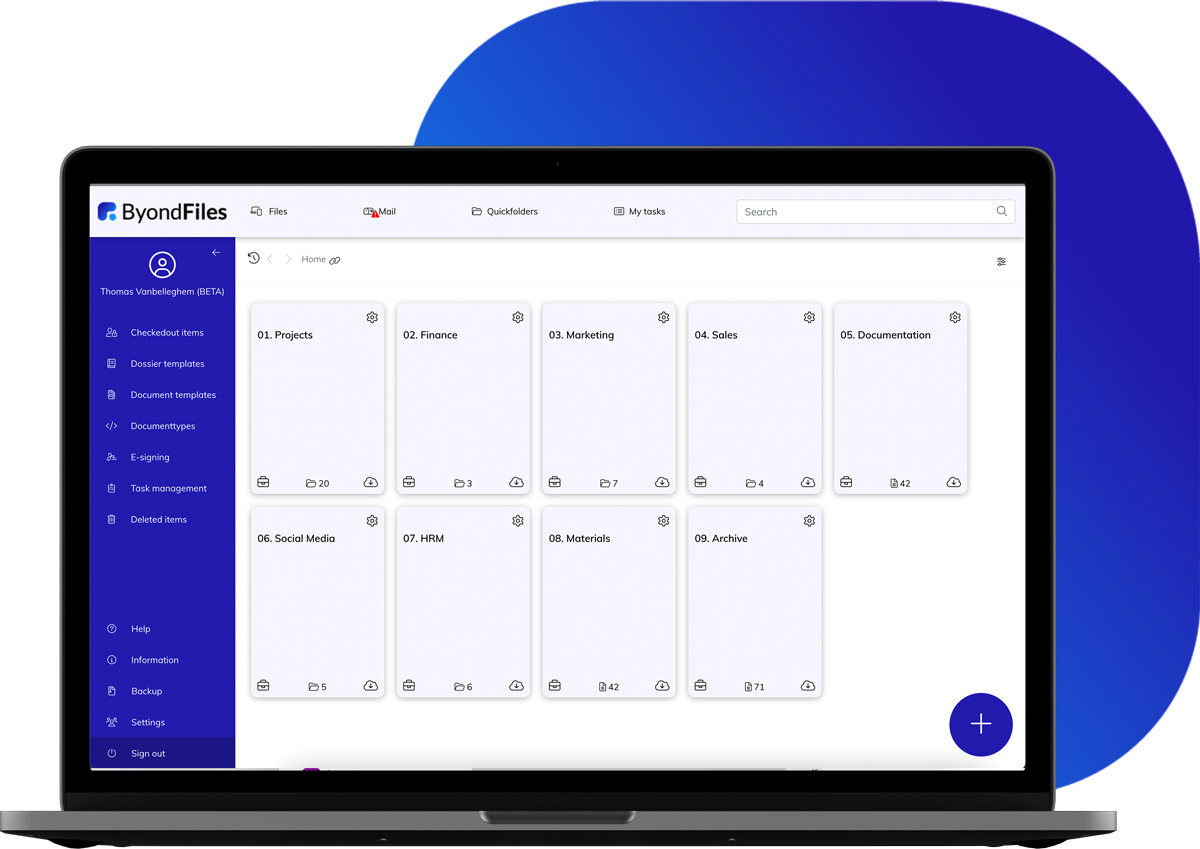Hoe schep ik orde in mijn documenten?
In 2012 rapporteerde McKinsey dat er gemiddeld 1,8 uur per dag verloren gaat door medewerkers die informatie zoeken en verzamelen. Volgens Interact Source gaat dan weer 19,8% van alle tijd verloren door het zoeken naar documenten. IDCdata plakt er een getal op van 2,5 uur per dag.
In 2018 werd een uitgebreide studie gedaan op Amerikaanse bedrijven en hun processen. Daaruit blijkt dat bijna 40% van alle werknemers slecht functionerende processen opmerkt bij document management binnen hun organisatie. 50% van de respondenten had problemen met het vinden van documenten, 43% heeft last met goedkeuring en delen van documenten terwijl 1 op 3 moeite heeft met het vinden van de juiste versies van een document.

Time is money
Zoeken naar documenten is niet alleen frustrerend voor werknemers, het is tijdsverspilling voor bedrijven. Snelle toegang tot informatie is de basis voor goeie beslissingen. Het ontbreken van informatie kan tot overhaaste of slecht geïnformeerde beslissingen leiden.
Tijdverlies kost elk bedrijf geld. De tijd dat werknemers informatie zoeken kan volgens Diamond, Inc. in het slechtste geval oplopen tot 20%. Dat wil zeggen dat 1 op 5 van de werknemers simpelweg niet tot werken toekomt, omdat men op zoek is naar verkeerd genaamde documenten in vergeten locaties.
Hoe bevordert een DMS een ordentelijke opslag van documenten
Data komt binnen in een continue flow die nooit stopt. De manier waarop bedrijven hier nu mee omgaan is vaak achterhaald en onnatuurlijk. Het is belangrijk dat er nagedacht wordt hoe er meer structuur in data kan worden gerealiseerd, aangezien een zoekbare databank de tijd gespendeerd aan zoeken met 35% kan verminderen.
Alle inspanningen dienen naar het afhandelen van een taak te gaan, en niet over het zoeken naar benodigde informatie. Een eerste manier waardoor het makkelijker wordt informatie te zoeken, is een uniforme naamgeving.
Centraal beheer
De eerste tip voor beter documentbeheer is een no-brainer. Bewaar alle informatie in een centrale tool. Niets is zo frustrerend als een volledig klantendossier te doorzoeken om dan te merken dat een bepaald bestand in een mailfolder opgeslagen zat. Het centraliseren van informatie kan een investering vereisen, maar tijdswinsten wegen uiteraard veel harder door.
Dossierstructuur en metadata
Eerst en vooral is het belangrijk dat er voor repetitieve projecten ook telkens identieke dossiers worden aangemaakt. Het is dus aan te raden hiervoor sjablonen of templates te gaan gebruiken.
Binnen deze sjablonen van de mappenstructuur is het ook een goeie tip om gebruik te maken van een hiërarchische nummering. Bovendien creëert men orde en overzicht, wanneer mappen op alle niveaus duidelijke en unieke namen krijgen, creëert men orde en overzicht. Hiermee kan veel tijd worden gewonnen.
De vindbaarheid van dossiers, mappen of documenten wordt ook vergroot met behulp van metadata. Metadata kan gezien worden als een post-it. Deze bevat dan aanvullende informatie die het makkelijker maakt bestanden of dossiers op te halen. Van de soort en status van een project, tot de betrokkenen of eindverantwoordelijke.
Naamgeving en metadata
Uniforme naamgevingsregels zijn cruciaal. Een goede naamgeving is kort en krachtig, en is vooral gekend bij alle collega’s. Belangrijke informatie kan zijn:
- Datering: Gebruik altijd de datum van een document in de naam. Zo kunnen deze gemakkelijk chronologisch gesorteerd worden.
- Dossiernummer of projectcode: Door deze informatie mee te geven in de bestandsnaam, kan alle informatie toebehorend aan een bepaald dossier samengebracht worden.
- Auteur: Sowieso is het altijd handig om te weten wie een bepaald document opstelde. Auteurs zullen altijd meer informatie kunnen voorzien in verband met een document.
Visueel overzicht
Een zoektocht naar een bepaald document is vaak een verhaal van vele malen bestanden openen, bekijken en sluiten. Een handige manier om dit te vermijden is het visueel voorstellen van alle documenten. Door een voorvertoning of pictogram van een document, plan of foto weer te geven is het veel makkelijker te herkennen.
Wanneer deze richtlijnen gevolgd worden zal er niet alleen veel minder irritatie heersen op de werkvloer, maar kan ook flink bespaard worden. Ontdek wat ByondFiles voor uw bedrijf kan doen.
